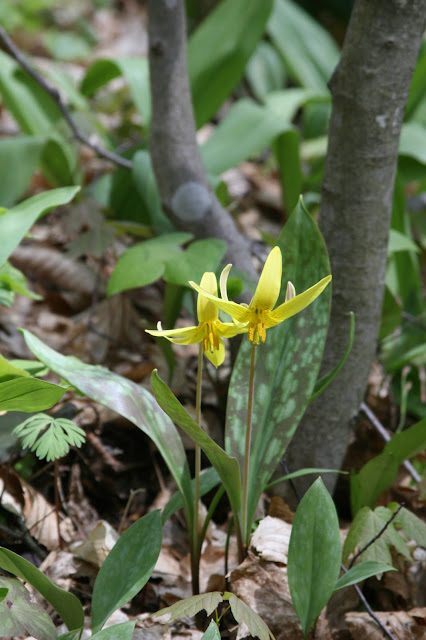If you want to catch one of these trout you can visit one of the Great Lakes or their tributaries. The Lake Trout and Brook Trout are both native to Michigan. The Rainbow and Brown Trout were introduced into the Great Lakes Watershed to increase sportfishing opportunities in the late1800s. In fact the current world record Brown Trout was caught in the Manistee River in 2009 and weighed 41.45 pounds (18.8 kgs).
These fish are not the only "trout" in Michigan. There are two other species, but to "catch" these you have you have to turn your back to the water and head into the woods.
You have to head into the woods because the other two species of "trout" are not fish, but wildflowers. Specifically they are lilies - Trout Lilies.
 |
| Part of a larger colony of Yellow Trout Lilies |
The White Trout Lily (Eythronium albidum) and Yellow Trout Lily (Erythronium americanum) are native wildflowers of deciduous forests of the eastern United States and Canada. Both are present in Mid-Michigan, but the the Yellow Trout Lily is more common - this is the extreme northern edge of the White Trout Lily's range.
 |
| White Trout Lily |
Both plants are spring ephemerals, meaning they bloom early in the spring before the trees in the canopy leaf out. Further south this can begin as early as late March. In Mid-Michigan they typically bloom between the third week and April and the second week of May.
 |
| Yellow Trout Lily |
So why are they called Trout Lilies? They are named because the grey mottled pattern on their green leaves resembles the speckling on the native brook trout. Sometime these plants are called Fawn Lilies for the resemblance to the speckling on a White-tailed Deer fawn. It is also known sometimes as a Dogtooth Violet or an Adder's Tongue.
 |
| Yellow Trout Lilies - note mottled pattern on leaves. |
This mottled pattern on the leaves makes trout lilies very easy to identify as a genus, but without the flowers it is impossible to identify the species. What makes this more difficult is the fact that the plant often does not bloom for many years. Blooming takes a lot of energy. Each plant must store up energy to produce a bloom- this can take up to seven years. In years that the plant does not bloom it sends up a single leaf. This leaf photosynthesizes sugar that is stored in the corm (bulb) of the plant. When enough sugar has been stored up, the plant will send up a second leaf and a bloom.
This requirement to store up energy means that the plant can often be found when it is not blooming. Sometime a population may not bloom for several years or only a very small portion of the population may bloom in any given year. I know of one population of white trout lilies that did not send up a single bloom for over six years and then bloomed profusely. This blooming was probably helped when beavers dropped many of the canopy trees allowing in more sunlight.
+1.jpg) | ||
| A single bloom found in 2003 - the colony did not bloom again until 2009. |
Basic Information
White Trout Lily
Eurythronium albidum
Habitat: deciduous forests
Height: 5 to 10 inches
Flower Color: white
Bloom Time: April to June
 |
| A mosquito on a White Trout Lily bloom |
Yellow Trout Lily
Eurythronium americanum
Habitat: deciduous forests
Height: 5 to 10 inches
Flower Color: yellow
Bloom Time: late March to June
 |
| A pollen covered bee in a Yellow Trout Lily |
oh wow mr. levalley you troll i thought it was a fish in the woods
ReplyDeleteAs far as I am aware we do not have any fish on land here is Michigan. However, the Walking Catfish (Clarias batrachus)a tropical species from Africa and southeast Asia has been accidentally introduced in the United States. This species has become invasive in Florida and Cailfornia, and has been reported in other areas of the country. It has the ability to breathe air and travels overland walking on its fins to find new territories. So maybe some day in the future we will have fish in the woods.
Delete